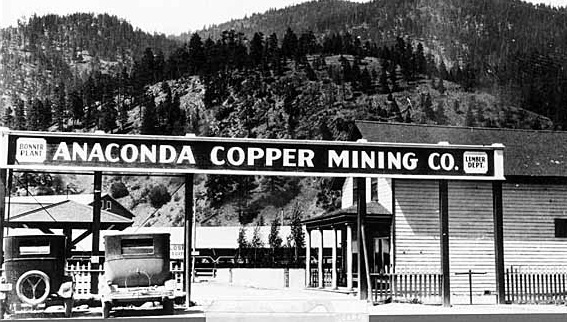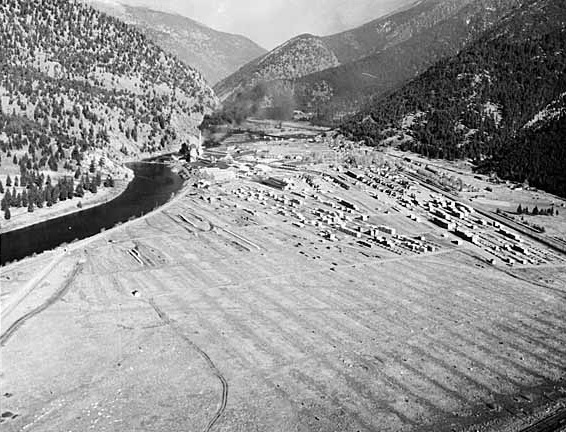 Anaconda Copper Mining Company in the 1920's From about 1886 to 1972, a single company--Anaconda Copper Mining--hired most of the working men of Bonner and Milltown. For about 20 of those years, a second company, Clark’s Western Lumber Company, also hired workers, but the Western was eventually absorbed by Anaconda. Over the years, the mill was known by various names, including the Hammond-Bonner lumber mill, the Big Blackfoot Milling Company, the Anaconda Mill, and, briefly, the Western Lumber Mill.
Anaconda Copper Mining Company in the 1920's From about 1886 to 1972, a single company--Anaconda Copper Mining--hired most of the working men of Bonner and Milltown. For about 20 of those years, a second company, Clark’s Western Lumber Company, also hired workers, but the Western was eventually absorbed by Anaconda. Over the years, the mill was known by various names, including the Hammond-Bonner lumber mill, the Big Blackfoot Milling Company, the Anaconda Mill, and, briefly, the Western Lumber Mill.
According to Polk’s City Directory for 1905, 250 men worked in the Big Blackfoot Mill and in the logging camps. Skilled jobs included a blacksmith, a foreman in charge of the yard, another in charge of the planer, the river operation, and the railroad. There were also several carpenters, three engineers, a millwright, a timekeeper, and four sawyers. The Hotel Margaret, where some of the mill men boarded and out of town guests stayed, had seven employees in addition to the proprietor, including a cook, two waiters, a chambermaid, a porter, a yardman, and a barber.
In 1928, Anaconda changed the equation in Bonner and Milltown, by acquiring the Western; Anaconda now owned two mills within a half-mile of each other, but not for long. Especially during the Depression, it did not make economic sense to run two mills in such close proximity. Most of Western's workers were hired by Anaconda, so when the transition occurred there was not a big upheaval. Workers for one saw mill did not find working for the other very different. Wages were comparable to what they were in Butte.
Working for the mill was not just a job, it was a life. Generation followed generation into the mill. Many boys went to work at 16, or even younger if they could get away with it. One resident recalled, "A great number of us young men just wanted to get into industry as soon as possible."
Early on, the basic laborer made $3.36 per day, while those doing saw work earned $5.00 per day, and the head sawyer earned $8.00. Men worked six days a week, and payday was every two weeks, although in the early days it was once a month. Before the railroad made the transport of logs possible in the winter, the mill would shut for several winter months and the men moved to the logging camps up the Blackfoot.
It was not uncommon for workers to stay at the mill for 30 to 50 years before retirement. Generally they found working conditions acceptable. There had been some labor unrest around 1908 and again in 1917-19 when the Industrial Workers of the World (IWW or Wobblies) struck at the Bonner Mill following strikes in Butte. They did not strike at the Western, which was thought to have more liberal working policies. The strikers, mostly Finns, lost their jobs.
The union ultimately came into the mill in 1942 bringing better working conditions and most importantly, establishing the principal of seniority. Nevertheless, in 1946 there was a six-month strike at the Bonner Mill between supporters of the AFL (mill workers) and the CIO (lumber camp workers). One retired mill worker remembered that Anaconda contributed to the tension. After that the AFL became the official union of the entire ACM Lumber Division. An aerial photo from the late 1930s shows a near empty log yard. The mill operated two to three days during the Depression. The Company closed the Company store once the union was adopted. Nevertheless some long-term workers suggested that overall "there were few strikes…[we have] never seen a more compatible relation between labor and management…everyone was on a first name basis…."
An aerial photo from the late 1930s shows a near empty log yard. The mill operated two to three days during the Depression. The Company closed the Company store once the union was adopted. Nevertheless some long-term workers suggested that overall "there were few strikes…[we have] never seen a more compatible relation between labor and management…everyone was on a first name basis…."
The Depression hit Bonner and Milltown hard but the mill tried to keep the work force together by only working three days or less. One resident remembered, "A lot of older folks retired and didn’t work again. It took about seven years to get back to normal. People 'got by.' During the Depression everyone hunted." A lot of the workers went into WWII, but no women were hired by the mill. Since military service counted toward seniority, "There was no problem getting a job after the war."
